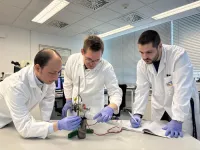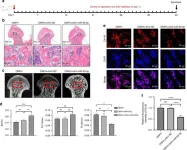(Press-News.org) If the archaeological record has been correctly interpreted, stone alignments in Tanzania’s Olduvai Gorge are remnants of shelters built 1.7 million years ago by Homo habilis, an extinct species representing one of the earliest branches of humanity’s family tree.
Archaeological evidence that is unambiguously housing dates to more than 20,000 years ago—a time when large swaths of North America, Europe and Asia were covered in ice and humans had only recently begun living in settlements.
Between that time and the dawn of industrialization, the archaeological record is rich not only with evidence of settled life represented by housing, but also with evidence of inequality.
In a PNAS Special Feature published today, scholars from around the world draw from a groundbreaking archaeological database that collects more than 55,000 housing floor area measurements from sites spanning the globe—data that support research demonstrating various correlations between housing size and inequality.
“Archaeologists have been interested in the study of inequality for a long time,” explains Scott Ortman, a University of Colorado Boulder associate professor of anthropology who partnered with colleagues Amy Bogaard of the University of Oxford and Timothy Kohler of the University of Florida to bring together the PNAS Special Feature. “For a long time, studies have focused on the emergence of inequality in the past, and while some of the papers in the special feature address those issues, others also consider the dynamics of inequality in more general terms.”
“They use this information to identify the fundamental drivers of economic inequality using a different way of thinking about the archaeological record—more thinking about it as a compendium of human experience. It’s a new approach to doing archaeology.”
Patterns of inequality
Ortman, Bogaard and Kohler also are co-principal investigators on the Global Dynamics of Inequality (GINI) Project funded by the National Science Foundation and housed in the CU Boulder Center for Collaborative Synthesis in Archaeology in the Institute of Behavioral Science to create the database of housing floor area measurements from sites around the world.
Scholars then examined patterns of inequality shown in the data and studied them in the context of other measures of economic productivity, social stability and conflict to illuminate basic social consequences of inequality in human society, Ortman explains.
“What we did was we crowdsourced, in a sense,” Ortman says. “We put out a request for information from archaeologists working around the world, who knew about the archaeological record of housing in different parts of world and got them together to design a database to capture what was available from ancient houses in societies all over world.”
Undergraduate and graduate research assistants also helped create the database, which contains 55,000 housing units and counting from sites as renowned as Pompeii and Herculaneum, to sites across North and South America, Asia, Europe and Africa.
“By no stretch of the imagination is it all of the data that archaeologists have ever collected, but we really did make an effort to sample the world and pull together most of the readily available information from excavations, from remote sensing, from LiDAR,” Ortman says.
The housing represented in the data spans non-industrial society from about 12,000 years ago to the recent past, generally ending with industrialization. The collected data then served as a foundation for 10 papers in the PNAS Special Feature, which focus on the archaeology of inequality as evidenced in housing.
Housing similarities
In their introduction to the Special Feature, Ortman, Kohler and Bogaard note that “economic inequality, especially as it relates to inclusive and sustainable social development, represents a primary global challenge of our time and a key research topic for archaeology.”
“It is also deeply linked to two other significant challenges. The first is climate change. This threatens to widen economic gaps within and between nations, and some evidence from prehistory associates high levels of inequality with lack of resilience to climatic perturbations. The second is stability of governance. Clear and robust evidence from two dozen democracies over the last 25 years that links high economic inequality to political polarization, distrust of institutions and weakening democratic norms. Clearly, if maintenance of democratic systems is important to us, we must care about the degree of wealth inequality in society.”
Archaeological evidence demonstrates a long prehistory of inequality in income and wealth, Ortman and his colleagues note, and allows researchers to study the fundamental drivers of those inequalities. The research in the Special Feature takes advantage of the fact “that residences dating to the same chronological period, and from the same settlements or regions, will be subject to very similar climatic, environmental, technological and cultural constraints and opportunities.”
Several papers in the Special Feature address the relationship between economic growth and inequality, Ortman says. “They’re thinking about not just the typical size of houses in a society, but the rates of change in the sizes of houses from one time step to the next.
“One thing we’ve also done (with the database) is arrange houses from many parts of the world in regional chronological sequences—how the real estate sector of past societies changed over time.”
The papers in the Special Feature on topics including the effects of land use and war on housing disparities and the relationship between housing disparities and how long housing sites are occupied. A study that Ortman led and conducted with colleagues from around the world found that comparisons of archaeological and contemporary real estate data show that in preindustrial societies, variation in residential building area is proportional to income inequality and provides a conservative estimator for wealth inequality.
“Our research shows that high wealth inequality could become entrenched where ecological and political conditions permitted,” Bogaard says. “The emergence of high wealth inequality wasn’t an inevitable result of farming. It also wasn’t a simple function of either environmental or institutional conditions. It emerged where land became a scarce resource that could be monopolized. At the same time, our study reveals how some societies avoided the extremes of inequality through their governance practices.”
The researchers argue that “the archaeological record also shows that the most reliable way to promote equitable economic development is through policies and institutions that reduce the covariance of current household productivity with productivity growth.”
GINI Project data, as well as the analysis program developed for them, will be available open access via the Digital Archaeological Record.
END
New archaeological database reveals links between housing and inequality in ancient world
2025-04-14
ELSE PRESS RELEASES FROM THIS DATE:
New, non-toxic synthesis method for “miracle material” MXene
2025-04-14
It is one of the most significant trends in materials science: materials that consist of only a single layer of atoms, so-called “2D materials”, often show completely different properties than thicker layers consisting of the same atoms. This field of research began with the Nobel Prize-winning material graphene. Now, research is being conducted into the material class of MXenes (pronounced Maxenes), which consist mainly of titanium and carbon, by TU Wien (Vienna) together with the companies CEST and AC2T.
These MXenes have properties that ...
Cutting-edge optical genome mapping technology shows promise for diagnosis, prognosis, and therapeutic options of multiple myeloma
2025-04-14
Philadelphia, April 14, 2025 – Researchers have demonstrated the potential of the innovative optical genome mapping (OGM) technique for the diagnosis, prognosis, and therapeutic management of multiple myeloma. This new study in The Journal of Molecular Diagnostics, published by Elsevier, details how this novel method can establish the cytogenomic profile of the tumor on a scale suitable for routine practice in cytogenetics laboratories.
Multiple myeloma, a type of blood cancer that forms in plasma cells (a type of white blood cells), is the second ...
Study looks at impact of COVID-19 pandemic on rates of congenital heart disease procedures among children
2025-04-14
Major reallocation of healthcare services during the COVID-19 pandemic meant that elective surgery in children with congenital heart disease (CHD) was significantly reduced, so that those needing urgent, lifesaving and emergency surgery could be treated. However, this prioritisation of the most severely ill children did not increase overall post-operative complications rates or death, a study led by the University of Bristol has shown.
The research, published in Open Heart, suggests that prioritising surgery for younger and more critically ill children may be appropriate when there is a sudden disruption of usual care. The ...
UH researcher unveils new model to evaluate impact of extreme events and natural hazards
2025-04-14
When you’re on a sandy beach or the banks of a river, transformed by rolling waves or slightly still waters, it’s likely you’re not thinking about what happens just beneath the surface, where dirt and pollution are swirling and traveling through to new destinations.
But Hanadi Rifai does. The Moores Professor of Civil and Environmental Engineering and director of the Hurricane Resilience Research Institute, has spent two decades examining Galveston Bay – its tides, currents ...
Illegal poisonings imperil European raptors and could disrupt ecosystem health
2025-04-14
A recent comprehensive assessment on the poisoning of raptors across Europe does not yield good news. This is according to the new paper “Poisoning in Europe Between 1996 and 2016: A Continental Assessment of the Most Affected Species and the Most Used Poisons,” published in the Journal of Raptor Research. A large team of raptor researchers amassed retrospective data on poisoning events across 22 European countries between 1996 and 2016. Carbofuran and aldicarb were the most common toxins reported and disproportionately affected scavenging raptors, especially in Northern ...
UF professor develops AI tool to better assess Parkinson’s disease, other movement disorders
2025-04-14
A University of Florida researcher has developed a groundbreaking open-source computer program that uses artificial intelligence to analyze videos of patients with Parkinson's disease and other movement disorders. The tool, called VisionMD, helps doctors more accurately monitor subtle motor changes, improving patient care and advancing clinical research.
Diego Guarin, Ph.D., an assistant professor of applied physiology and kinesiology in UF’s College of Health and Human Performance, created the software to address the potential risk of inconsistency ...
Computer science professor elected AAAS Fellow
2025-04-14
Dr. Latifur Khan, professor of computer science at The University of Texas at Dallas, has been elected to the 2024 class of American Association for the Advancement of Science (AAAS) fellows.
Khan is one of 471 scientists, engineers and innovators to be recognized across 24 disciplinary sections. The new fellows will be honored at a June 7 event in Washington, D.C.
The AAAS elected Khan in the section on information, computing and communication for “distinguished contributions to the field of machine learning with applications to cybersecurity, social sciences ...
Learning about social interaction by studying dancing
2025-04-14
Dancing fluidly with another involves social coordination. This skill entails aligning movements with others while also processing dynamic sensory information, like sounds and visuals. In a new JNeurosci paper, Félix Bigand and Giacomo Novembre, from the Italian Institute of Technology, Rome, and colleagues report their findings on how the brain drives social coordination during dance.
The researchers recruited pairs of inexperienced dancers and recorded their brain activity, whole-body movements, and ...
Immune cell 'messengers' could save crumbling bones - new hope for joint pain sufferers
2025-04-14
A recent study has uncovered a potential breakthrough in treating osteonecrosis of the femoral head (ONFH), a debilitating bone disease that causes severe pain and joint collapse. Researchers have discovered that exosomes derived from M2 macrophages-derived exosomes (M2-Exos) can significantly improve bone regeneration by modulating neutrophil extracellular traps (NETs) and endothelial cell function. These tiny vesicles, packed with miR-93-5p, were shown to reduce harmful NETs formation and enhance ...
Fishing for cephalopod DNA allows for efficient marine surveying
2025-04-14
New DNA probes allow for efficient surveying of the hidden lives of squids and octopuses in the deep sea. This development by Kobe University provides an effective tool for marine ecological research and conservation efforts.
Squids and octopuses eat and are eaten, and in between that they move around a lot. “Cephalopods play an important role in marine ecosystems, contributing to the distribution of energy and nutrients in the food web,” explains Kobe University marine ecologist WU Qianqian. And while for ecological research it is therefore essential to know about the distribution ...





